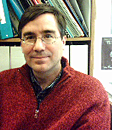| |
Jacques Michaud, M.D.
 Dr. Jacques Michaud is a physician in the Department of Medical Genetics at the
CHU Sainte-Justine. Dr. Jacques Michaud is a physician in the Department of Medical Genetics at the
CHU Sainte-Justine.
CONTACT
CHU Sainte-Justine Research Centre
3175 Cote-Ste-Catherine
Montreal, Quebec
Canada H3T 1C5
Phone: 514-345-4727
Email :jacques.michaud@recherche-ste-justine.qc.ca
SUMMARY OF RESEARCH ACTIVITIES
Our laboratory research concentrates on dissecting the developmental program of the paraventricular nucleus (PVN), a small group of neurons located in the hypothalamus. Its size and well-characterized cellular composition make the PVN an interesting model for studying the fundamental mechanisms controlling the differentiation of neurons and the generation of cellular diversity of the brain. PVN neurons participate in controlling a large number of physiological phenomena including appetite, thirst and response to stress. We have postulated that the study of PVN development will also allow us to better understand diseases affecting the physiological phenomena.
In April 2006, the laboratory initiated an important research project focused on identifying genes responsible for mental retardation. During this five-year project, 300 genes involved in synapses will be studied in 285 subjects suffering from non-syndromic mental retardation. The most interesting variations will become the subjects of a more in-depth functional biological study.
Par ailleurs, le laboratoire à initié en avril 2006 un important projet de recherche visant à identifier les gènes responsables du retard mental. Dans le cadre de ce projet d’une durée de cinq ans, 300 gènes jouant un rôle au niveau de la synapse seront étudiés chez 285 sujets souffrant de retard mental non syndromique. Les variations les plus intéressantes feront l’objet d’une étude biologique fonctionnelle plus poussée.
STUDIED DISEASES
Mental retardation
SELECTED PUBLICATIONS
Michaud JL, Rosenquist T, May N, and Fan C-M. (1998). Development of neuroendocrine lineages requires the bHLH-PAS transcription factor SIM1. Genes & Development, 12:3264-3275.
Michaud JL, DeRossi C, May NR, Holdener BC and Fan C-M. (2000). ARNT2 acts as the dimerization partner of SIM1 for the development of the hypothalamus. Mech. Dev. 90:253-261.
Michaud JL, Boucher F, Melnyk A, Gauthier F, Goshu E, Levy E, Mitchell GA, Himms-Hagen J and Fan C-M. (2001). Sim1 haploinsufficiency causes hyperphagia, obesity and reduction of the paraventricular nucleus of the hypothalamus. Hum. Mol. Genet., 10:1465-1473.
Piao X, Hill RS, Bodell A, Chang BS, Basel-Vanagaite L, Straussberg R, Dobyns WB, Qasrawi B, Winter RM, Innes M, Voit T, Ross ME, Michaud JL, Décarie J-C, Barkovich AJ, and Walsh CA. (2004) Patterning of human frontal cortex by an orphan G protein-coupled receptor. Science, 303:2033-2036.
Goshu E, Hui J, Marion JF, Michaud JL and Fan C-M. (2004) Sim2 defines region-specific neuroendocrine cell types in the anterior hypothalamus. Mol. Endocrinol., 18:1251-62.
Marion JF, Yang C, Caqueret A, Boucher F and Michaud JL. (2005). Sim1 and Sim2 are required for correct targeting of mammillary body axons. Development, 132:5527-5537.
Caqueret A, Coumailleau P and Michaud JL. (2005). Regionalization of the anterior hypothalamus in the chick embryo. Developmental Dynamics, 233:652-658.
Yang C, Gagnon D, Vachon P, Levy E, Tremblay A, Massie B and Michaud JL. (2006). Adenoviral-mediated modulation of Sim1 expression in the paraventricular nucleus affects food intake. The Journal of Neuroscience, 26 :7116-7120.
Caqueret A, Boucher F and Michaud JL. (2006). Laminar organization of the early developing hypothalamus. Developmental Biology, 298:95-106.
Crow YJ, Hayward BE, Parma R, Robins P, Leitch A, Ali M, Black DN, Bokhoven HV, Brunner HG, Corry PC, Cowan FM, Frints SG, Klepper J, Livingston JH, Lynch SA, Massey RF, Meritet JF, Michaud JL, Voit T, Lebon P, Bonthron DT, Jackson AP, Barnes DE and Lindahl T. (2006). Mutations in the gene encoding the 3’ 5’ DNA exonuclease TREX1 cause Aicardi-Goutières syndrome at the AGS1 locus. Nature Genetics, 38:917-920.
USEFUL LINKS
CHU Ste-Justine Research Centre
Synapse to Disease Project
 Top Top
|


 Dr. Jacques Michaud is a physician in the Department of Medical Genetics at the
CHU Sainte-Justine.
Dr. Jacques Michaud is a physician in the Department of Medical Genetics at the
CHU Sainte-Justine.